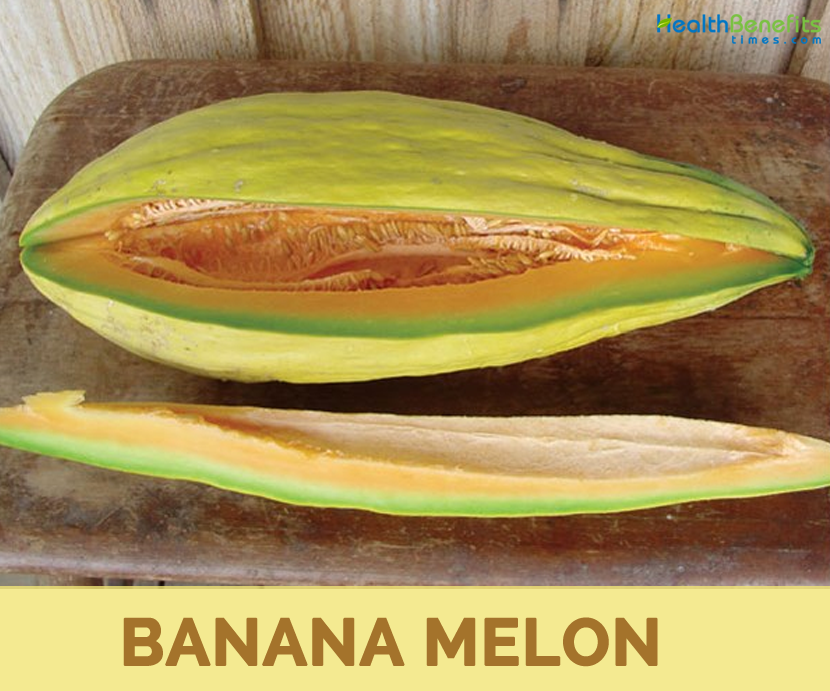| Banana Melon Quick Facts | |
|---|---|
| Name: | Banana Melon |
| Colors | Green when young turning to yellow as they ripe |
| Shapes | Banana shaped melons up to 16 to 24 inches long and 4 inch in diameter |
| Taste | Salmon-colored flesh |
| Calories | 21 Kcal./cup |
| Major nutrients | Vitamin C (9.00%) Vitamin B9 (5.00%) Vitamin K (4.08%) Copper (3.89%) Vitamin B6 (3.85%) |
Plant Description
Banana melon plant is a vining warm season plant that grows in full sunlight location and prefers well-drained, fertile soil amended with compost or well-rotted manure. A 2-inch layer of compost or dry manure should be worked into the soil over the planting area to about a depth of 6 inches. The plant yields tasty elongated banana shaped melons up to 16 to 24 inches long and 4 inch in diameter and average weight up to 5 to 8 pounds each. Fruit is normally green when young turning to yellow as they ripe. Banana melon has smooth yellow skin and salmon-colored flesh. Banana melons rapidly turn yellow in a short time as it ripens. You can also check the stem of each fruit for dryness. Ripe fruits have a dry stem that is brown and somewhat shriveled. Ripe fruit has mild, distinctive, evocative flavor and luscious, papaya-like texture.
Nutritional Values of Banana Melon
Apart from their mild, distinctive, evocative flavor and luscious, papaya-like texture, Banana melon is a good source of nutrients, vitamins and minerals. Consuming 100 gram of Banana melon offers 8.1 mg of Vitamin C (Ascorbic acid), 20 µg of Vitamin B9 (Folate), 4.9 µg of Vitamin K (phylloquinone), 0.035 mg of Copper, 0.05 mg of Vitamin B6 (Pyridoxine), 4.06 g of Carbohydrate, 140 mg of Potassium, 0.46 mg of Vitamin B3 (Niacin) and 0.21 mg of Iron.
Calories 21 K cal. Calories from Fat 1.8 K cal.
| Proximity | Amount | % DV |
|---|---|---|
| Water | 94.66 g | N/D |
| Energy | 21 Kcal | N/D |
| Energy | 90 kJ | N/D |
| Protein | 0.84 g | 1.68% |
| Total Fat (lipid) | 0.2 g | 0.57% |
| Ash | 0.24 g | N/D |
| Carbohydrate | 4.06 g | 3.12% |
| Total dietary Fiber | 0.3 g | 0.79% |
| Total Sugars | 3.36 g | N/D |
| Glucose (dextrose) | 1.3 g | N/D |
| Fructose | 2.06 g | N/D |
| Minerals | Amount | % DV |
|---|---|---|
| Calcium, Ca | 13 mg | 1.30% |
| Iron, Fe | 0.21 mg | 2.63% |
| Magnesium, Mg | 10 mg | 2.38% |
| Phosphorus, P | 9 mg | 1.29% |
| Potassium, K | 140 mg | 2.98% |
| Sodium, Na | 11 mg | 0.73% |
| Zinc, Zn | 0.14 mg | 1.27% |
| Copper, Cu | 0.035 mg | 3.89% |
| Manganese, Mn | 0.036 mg | 1.57% |
| Selenium, Se | 0.4 µg | 0.73% |
| Vitamins | Amount | % DV |
|---|---|---|
| Water soluble Vitamins | ||
| Vitamin B1 (Thiamin) | 0.02 mg | 1.67% |
| Vitamin B2 (Riboflavin) | 0.018 mg | 1.38% |
| Vitamin B3 (Niacin) | 0.46 mg | 2.88% |
| Vitamin B5 (Pantothenic acid) | 0.07 mg | 1.40% |
| Vitamin B6 (Pyridoxine) | 0.05 mg | 3.85% |
| Vitamin B9 (Folate) | 20 µg | 5.00% |
| Folate, food | 20 µg | N/D |
| Vitamin C (Ascorbic acid) | 8.1 mg | 9.00% |
| Fat soluble Vitamins | ||
| Vitamin K (phylloquinone) | 4.9 µg | 4.08% |
Source:
https://ndb.nal.usda.gov/
Culinary Uses
- This melon is wonderful as a dessert or snack.
- It is also use to perk up salads, salsas, entrees and drinks.
Comments
comments
